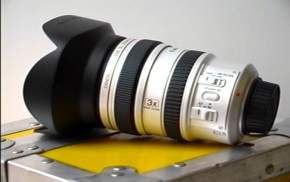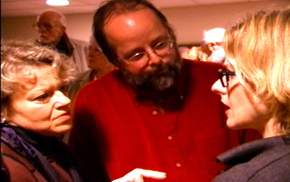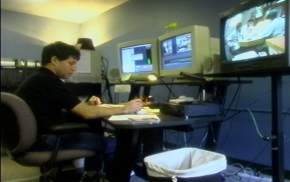The XL1 Watchdog
|
> top of page < |
The Canon 3x Wide Angle Zoom Lens
an article by Jim MacAlister
The Watchdog notes: Jim MacAllister has been a visual artist making videos in Boston for over 25 years. He thinks the Canon XL1 is great in spite of its faults. His work includes award-winning corporate and medical videos and nationally seen documentaries. He is a born-again pagan, lives life passionately and wonders what will happen next.
When I purchased my XL1, I knew I would also purchase the 3x wide angle zoom lens when it came on the market. The best estimate that my dealer and Canon could offer for a pricing on the 3x was around $700, so the most disappointing thing I've encountered about the 3x lens was its price tag which turns out to be a hefty $1250.00.

The 3x lens equipped with its fluted, black plush lined sunshade is a bit shorter in length than the 16x, but it is close enough in length and shape to fit easily in the same case with custom foam cut out for the XL1 with the 16x lens attached. The 3x is a bit lighter at 670g (approximately 1.5 lb.) than the 820g (approximately 2 lb.)16x lens. This half pound seems like it should translate into slightly more comfortable hand held shooting, but I haven't found any noticeable difference. My arm still aches after half an hour of shooting.
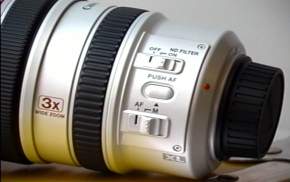
The controls on the 3x lens duplicate those on the 16x lens, except that the wide angle zoom does not have Canon's optical image stabilization feature. Being a wide angle zoom lens, 3.4 mm - 10.2 mm, the 3x doesn't really need stabilization, but it would help justify the cost. One of the reasons that a wide angle lenses are favored by shooters for hand held camera work is that shakiness is minimized--just the reverse of the way it is magnified by a long telephoto lens.
This brings up an interesting point: you have to be a much steadier shooter when working in video than in film. Unsteadiness that would look wretched at 60 images per second is perfectly acceptable at the lower frame rates of 24-30 frames per second. Even "shaky cam", which is highly choreographed and stylized, looks better on film than on straight video. However, if like many XL1 users, you have fallen in love with the XL1's "frame" movie, you may have noticed this has the same smoothing effect . This is due to the progressive scanning of the CCD 30 times per second producing only 30 images for every 60 fields rather than interlacing 60 unique images into 30 frames. In addition, "frame" movie mode footage appears to hold highlights and reduce the usual edginess of video, flattening the image, introducing jutter and delivering one of the best "film looks" I've seen. But I digress...

With one notable exception, I've been very pleased with the performance of the 3x lens. That exception occurred when I was asked to shoot a chamber music performance at a church from the balcony about 60 feet from the musicians. I mistakenly brought only the 3x lens and left the 16x at the office. As you can see from the image (left) above, one thing the 3x is not good at is getting a tight bust shot from that distance. That's my 10.2 mm end of the 3x shot. Since then, I've converted an old O'Connor 50 tripod head case into a lens case for whichever lens is not on the camera (right). I'll take both cases on most shoots because the 3x lens did do a great job of shooting the reception after the concert (below).
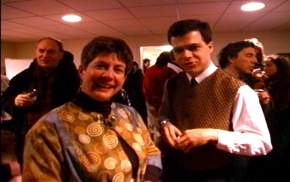
All these images were shot using available light . They are not beautifully lit shots, but are presented to give you an idea of the performance of the Canon's 3x lens for the XL1.
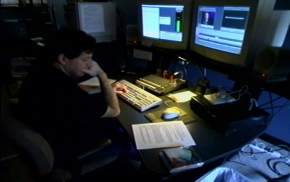
I shot the footage above while I was directing an AVID edit at Boston Digital Editing with freelance video editor, Arnie Harchik. These first two images are the ends of a short pan with me standing approximately 6 feet from Arnie at 3.4 mm, or full wide. If you look at the monitors in the two shots, you'll get some idea of the amount of distortion introduced by the lens. There is some, but I don't think it is objectionable.
Here's a shot of Arnie taken from next to the monitor to his left in the top two frames. Its a nice loose bust shot given the tight confines with the camera only four feet away from Arnie. Just the ticket for shooting those cubicle-computer-operator shots we all know and love.

The two frames above give you an idea of the 3x range of the lens. I'm about 6-8 feet from Arnie. The left shot is the 10.2 mm end of the lens and on the right, the 3.4 mm. Both the 16x and 3x lenses use 72 mm filters. These shots look a bit fuzzy due to my experimenting with a 1 Warm Pro Mist Tiffen filter. I wish Tiffen made a .25 or .5 Warm Pro Mist filter in the 72 mm size because the 1 Warm Pro plays too misty for me. The Watchdog notes: this is Jim's twisted Scottish humor at work here, with a pun that would make Clint Eastwood cringe. The Watchdog encourages this style of writing among his contributor's submissions wholeheartedly.
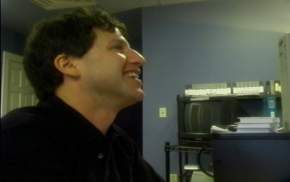
Here are two more frames showing the range of the 3x lens. I'm kneeling by the waste basket seen above.

These two frames were shot during a recording session with my son's rock band, Third Rail. I'm doing the music video and so I shot during the recording session with lots of camera movement and dutched angles. The first shot (left) is of our engineer and friend, Mike Cassiere, who tips the scales at over 300 lb. I'm shooting with the camera about 3 feet from Mike. The shaded window behind him is about 9-10 feet away. You'll notice that the lines and angles of the room remain pretty square looking. Its also possible to get some nice distorted views, such as the low angle shot of my son playing guitar (right) where the camera is full wide and the sunshade is touching the body of the Stratocaster guitar. Even under dim available light with the camera touching the instrument, focus remained acceptable over the image so that the pickups on the guitar are just barely soft with my son's face in sharp focus. As you would expect, the 3.4 mm end of the lens is more forgiving of non-critical focus and has a 2 cm minimum object distance (MOD). The 10.2 mm telephoto end of the lens has an MOD of half a meter. When doing this shooting, I was able to use the combination of the XL1's light weight, the pivoting viewfinder and the 3x lens to smoothly "fly" the camera up down and around members of the band as they played with the lens only inches away from their instruments, producing some dramatically distorted footage.
In the last image above, I have stepped out of the room into a small, 4 foot long hallway . I am shooting at full wide back into the room as my son plays. The 3x lens does a nice job of making the cramped space look much bigger and the lines of the walls and door jamb bow very little even at the full wide end of the lens.
Anyone who has shot with both regular and wide angle TV zoom lenses will realize that having both is more of a necessity than a luxury . You may have to use a long lens one day to get close enough to bashful harbor seals to see their whiskers, and the next day, you need the widest wide angle to shoot a loose bust shot of someone driving a car from the passenger side. If you use a Steadicam device, jib arm, or dolly, you know that a wide angle lens can produce some wonderful angles and perspectives. I've also used a wide angle adapter on the 16x lens before getting the 3x. The adapter had 3 distinct disadvantages: first, it was heavy; second, it couldn't be zoomed through, so you were stuck with one focal length; and third, it ended up coming loose, falling off and shattering on the floor. That set me back $250 and eliminated the wide angle option for that day. Of course, there are wide angle attachments that can be zoomed through, but these are generally four times as expensive, even heavier and, therefore, more likely to end up in pieces.
Even with my Scottish blood and keen sense of thrift, the cost of the 3x lens seems like a small price to pay for the versatility it delivers. And finally, offering the 3x lens with my XL1 camera has made me a more attractive package to knowledgeable producers who want some of the options they have with Betacam camcorders.
Back to the XL1 Articles Menu
Thrown together by Chris Hurd
Please direct questions to the DV Info Net Community Forums.
Where to Buy: These dealers are authorized DV Info Net sponsors... | |||
|
|
|
|
|
|
|
|
Please support this site by making your purchases through them. Thanks! | |||
©1998-2008 DV Info Net
The Digital Video Information Network
San Marcos, Texas
A word to the wise is infuriating.

